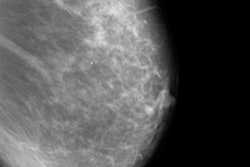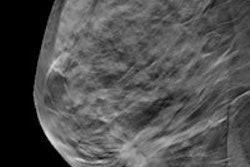
Dutch researchers have developed a new mammography paddle that they believe will ease the compression discomfort that patients experience during mammography exams, according to a study to be presented at the upcoming RSNA 2014 meeting.
Discomfort and pain from mammography compression can deter women from undergoing regular screening. In addition, over- or undercompression due to technologists' adjustment of the mammography device to accommodate breast size, composition, skin tautness, and a woman's pain tolerance can negatively affect image quality and/or expose the woman to extra radiation, according to lead author Woutjan Branderhorst, PhD, from the Academic Medical Center in Amsterdam, and colleagues.
Branderhorst's team has developed a mammographic paddle that uses pressure (the ratio of force to the area over which it's applied) rather than force (the total impact of one object on another). The paddle is identical to those used in traditional mammography, except that it includes an electrically conducting foil and a computer that measures the paddle's contact area with the breast to calculate the mean pressure needed, in real-time, according to the researchers.
 Woutjan Branderhorst, PhD, from the Academic Medical Center in Amsterdam.
Woutjan Branderhorst, PhD, from the Academic Medical Center in Amsterdam."By using pressure, the compression is automatically better adjusted to size and mechanical properties of the individual breast," Branderhorst told AuntMinnie.com by email. "This makes the procedure more reproducible and avoids unnecessary pain -- which could improve women's screening compliance."
For the study, Branderhorst's group included 433 asymptomatic women scheduled for screening mammography. Each woman underwent four compressions, three of which were standardized to a target force of 14 dekanewtons (daN). The fourth compression was standardized to a target pressure of 10 kilopascals (kPa).
The women rated any pain they experienced on a numerical rating scale, with 0 being the lowest pain score and 10 being the highest; three breast radiologists marked images that needed to be reacquired due to poor image quality.
"10 kPa is just below normal diastolic blood pressure, and 14 daN compares to 31 pounds, or the weight of a 3-year-old child," Branderhorst told AuntMinnie.com.
The group found that the 10-kPa pressure did not compromise radiation dose or image quality, and it improved the women's pain scores. The average glandular dose (AGD) on the device used in the study ranged from 1 mGy to 4 mGy for both protocols; AGD values were 0.5% to 3.2% lower with the 10-kPa protocol than with the 14-daN protocol, despite an average increase in breast thickness, the group reported.
The number of retakes requested was higher with the 10-kPa protocol, but almost all of these retakes were due to inadequate positioning rather than poor image quality, according to the researchers. The proportion of retakes requested for the 10-kPa compressions was 4.2%, compared with 1.4% for the 14-daN compressions.
"What became clear is that the reason why the observers requested retakes was almost always inadequate positioning; hardly any images were found to have inadequate compression (contrast, sharpness, spreading)," Branderhorst told AuntMinnie.com. "This difference disappeared after extra training of the technologists and adjustment of the software, and we've successfully used the 10-kPa protocol for more than eight months without problems."
Average pain scores for craniocaudal views decreased 23%, from 5.2 for the 14-daN protocol to 4.0 for the 10-kPa protocol. Scores decreased 10% for mediolateral views, from 5.2 to 4.7.
With an estimated 600 million breast compressions performed per year worldwide, this new mammography paddle could be a good way to improve women's screening experience, and it can easily be added to existing mammography systems, according to the group.
"The paddle will make mammography screening more predictable for every woman," the researchers told AuntMinnie.com.



















